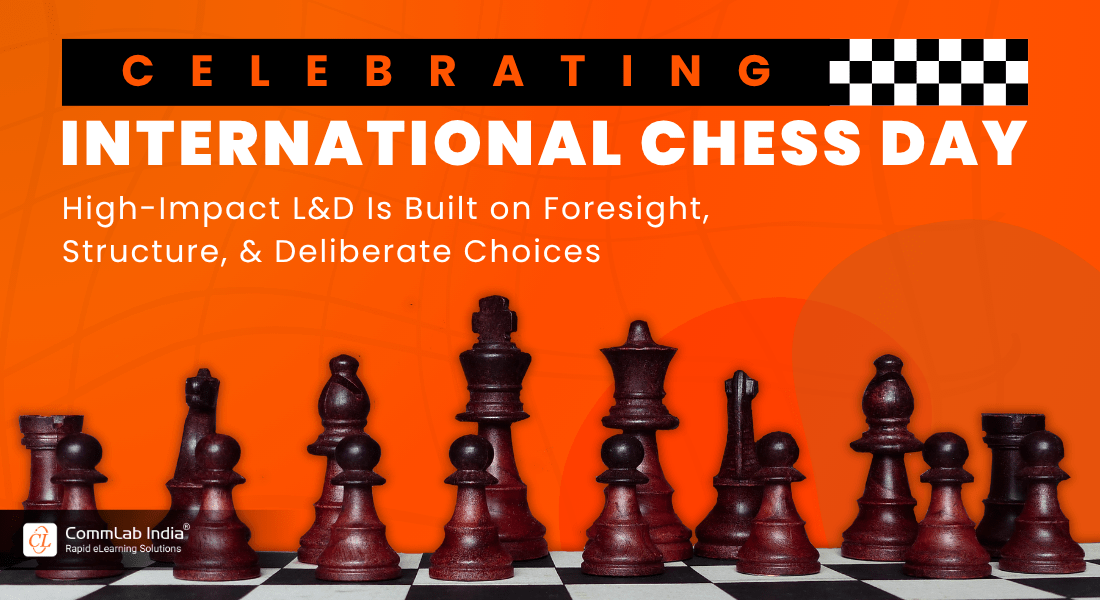
Strategize Your L&D Like a Grandmaster: 4 Key Questions
Every July 20th, the world celebrates Chess, a game of deep strategy, calculated risk, and constant learning. While the 64-square board may seem far removed from corporate training, its principles offer timely lessons for those shaping the future of learning in the workplace.
In chess, success doesn’t come from the flashiest move. It comes from structure, foresight, adaptability, and discipline. The same is true for Learning and Development (L&D). As organizations evolve, L&D leaders must move beyond reactive training and embrace strategy-driven, systems-oriented approaches to capability building.
This World Chess Day, take a moment to reflect:
Is your L&D strategy deliberately designed to drive business performance, or is it simply reactive, moving without a long-term game plan? Here are four strategic questions that can help you align your L&D initiatives like a grandmaster.
→ Download eBook: An L&D Manager’s Implementation Guide
Table Of Content
Is Your Learning Ecosystem Strategically Positioned Like a Chessboard?
A successful chess game starts with the correct placement of pieces. Likewise, effective L&D starts with a strong infrastructure, the Learning Management System (LMS).
An Enterprise LMS should not be viewed as a backend utility. It is your strategic command center, enabling structure, visibility, scalability, and learner autonomy.
Key capabilities to expect
- Role-based learning paths with adaptive sequencing
- Support for varied modalities: ILT, Virtual Instructor-led Training Sessions (VILT), eLearning, and beyond
- Real-time performance data and analytics
- Integration with microlearning apps to promote continuous, mobile learning
Just as chess players gain control by mastering the center of the board, L&D leaders can drive outcomes by configuring their LMS for strategic enablement, not just content delivery.
A powerful learning infrastructure, however, is only as effective as the content and experiences it delivers. That’s where instructional design becomes critical.
Are You Applying Instructional Design as Your Core Strategy?
How Can You Strengthen Instructional Design in Your L&D Strategy?
- Align learning objectives with business and learner needs
- Choose the right tools for authoring, engagement, and collaboration
- Incorporate real-world scenarios and interactivity to boost relevance
- Measure learning outcomes, not just participation
- Refine content through stakeholder feedback and continuous improvement
- Integrate continuous learning paths instead of one-off interventions
Behind every great move in chess lies a plan. Similarly, behind every effective learning experience lies thoughtful instructional design.
What is instructional design?
It is a structured approach to creating learning experiences that are goal-oriented, learner-centric, and outcome-driven. Using models like ADDIE or SAM, L&D professionals can ensure that each program:
- Aligns with organizational goals and learner needs
- Incorporates real-world relevance and interactivity
- Measures performance, not just participation
- Evolves based on feedback and impact metrics
Instructional design isn’t just content development; it is the strategic blueprint that defines how learning translates into capability and business value.

Once the instructional framework is in place, the next step is selecting the right tools to design and deliver impactful, scalable learning experiences. These tools typically fall into three key categories:
1. Course Authoring and Development Tools
Instructional designers use the below tools to build interactive, structured eLearning modules:
- Articulate Storyline & Articulate Rise allows for responsive course design, branching scenarios, and assessments tailored to various devices and learning contexts.
- Adobe Captivate is ideal for technical training, enabling the creation of software simulations, screen recordings, and adaptive learning paths.
- Lectora supports accessibility standards (like WCAG) and is highly effective for building multilingual content at scale.
- Murf.AI generates lifelike voiceovers from text, allowing designers to add professional narration to courses without the need for studio recordings.
2. Visual and Multimedia Tools for Engagement
To enrich the learning experience and support blended formats, below tools are used for animation and storytelling:
- Vyond enables the creation of animated videos and scenario-based content that increases learner engagement.
- Powtoon supports dynamic motion graphics and visual explainers, perfect for onboarding, soft skills, or microlearning interventions.
- HeyGen, powered by AI, allows instructional designers to generate talking-head videos with realistic avatars, ideal for delivering personalized, presenter-style content at scale without traditional video production.

An L&D Manager’s Guide to Successful Planning & Implementation.
Learn:
- What Challenges do L&D Managers Face?
- How to Align Business and Project?
- How to be a Learning Consultancy?
- DOWNLOAD NOW!
3. Collaboration and Review Platforms
To streamline content development and ensure quality, below tools are used:
- Articulate Review integrates directly with Storyline, enabling internal teams and SMEs to review and comment on modules in real-time.
- ReviewLink offers a centralized platform for gathering feedback, approving content, and managing version control during development.
- Frame.io, enhanced by AI, supports collaborative video reviews with features like auto-transcription, time-stamped comments, and intelligent version tracking, ideal for teams working on multimedia-heavy eLearning projects.
When instructional design tools are used within structured models like ADDIE or SAM, they enable the creation of learning experiences that are not only engaging and interactive but also efficient, often reducing training time by 40–60% compared to classroom delivery.
Are You Customizing Learning to Reflect Business Realities?
In professional chess, players don’t rely on generic tactics. They develop a personalized repertoire tailored to their strengths and playing style. In the same way, organizations must move beyond generic training to adopt custom eLearning solutions.
Custom eLearning is not simply tailored content; it’s a strategy to mirror organizational processes, technologies, compliance needs, and cultural tone. It enables:
- Alignment with company-specific systems and priorities
- Scenario-based learning that reflects real-world decision-making
- Consistency in branding and messaging across departments
- Scalability through eLearning translations for global learners
For even greater flexibility and engagement, blended learning combines multiple delivery formats such as ILT, VILT, self-paced modules, and collaborative platforms to offer a seamless, adaptive learning experience. This approach accommodates diverse learning styles, job roles, and operational contexts.
Custom and blended solutions together ensure that training is not only relevant and inclusive but also scalable and performance driven. To sustain the momentum of learning, frequent reinforcement is essential. This is where microlearning comes into play.
Watch how blended learning creates impactful training experiences!
Are You Using Microlearning to Build Tactical Agility?
Great chess players sharpen their tactics daily, small patterns that create major advantages. In L&D, that’s the role of microlearning.
Microlearning focuses on delivering highly relevant content in short, digestible formats. It’s an ideal solution for today’s attention-constrained, digitally connected learners.
Strategic applications include:
- On-the-job reinforcement post-training
- Pre-learning primers before complex sessions
- Compliance reminders and product refreshers
- Performance support delivered through microlearning apps
Watch how microlearning, when applied strategically, supports real-time performance and reinforces learning exactly when and where it’s needed.
Just as a chess player relies on repeated drills to recognize patterns and respond with speed, microlearning helps employees retain and apply knowledge quickly, confidently, and in the flow of work.
As every move in chess contributes to the endgame, each learning decision should support a larger strategy, one that aligns people, processes, and performance.
The End Game
Building a resilient L&D function isn’t about quick wins. It’s about thoughtfully combining the right tools, be it a structured LMS, strong instructional design, custom learning pathways, or timely microlearning, into an integrated whole.
At CommLab India, we’ve collaborated with global organizations to design scalable learning solutions rooted in practical business needs.
If you’re looking to refine your approach to digital learning, this guide may offer useful direction.
It covers the essential components of effective custom eLearning, from stakeholder alignment to rapid development of best practices.







